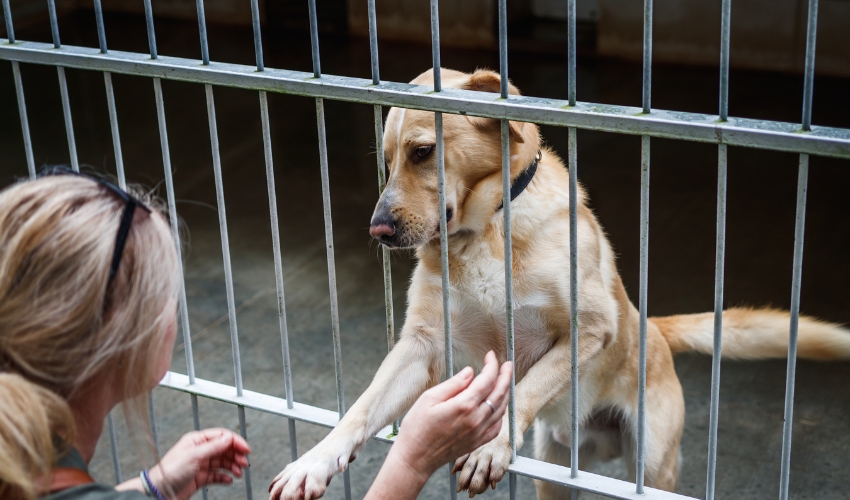Are you afraid that your pets may get distemper? Or perhaps, curiosity strikes, and you suddenly want to know what animals can get distemper? This article will help you understand distemper in general, in line with all the concerns that brought you here.
What Is Distemper?
Canine distemper is very contagious, and wild and domestic carnivores are affected by this common illness. Young and unvaccinated animals are more prone to the virus.
Direct contact with contaminated saliva, urine, feces, or respiratory secretions can result in the transmission of the disease. Since it doesn’t persist for a long time outside of the body, close animal contact is necessary for infection.
Symptoms such as eye and nasal discharge, wheezing, coughing, and pneumonia appear 10–14 days after contracting the distemper virus. More frequent symptoms are fever, anorexia, and respiratory problems. Additionally, the virus produces gastrointestinal issues, swelling of the foot pads, and neurological difficulties resembling rabies, making it challenging to distinguish.
What Might Get Distemper?
Are you wondering what animals can get distemper? Some of those would be the following:
- Badger
- Bear
- Cat
- Dog
- Elephant
- Ferret
- Fox
- Hyena
- Lion
- Tiger
- Mink
- Monkey
- Otter
- Racoon
- Red Panda
- Seal
- Sea Lion
- Skunk
- Walrus
- Wol
The common symptoms listed below are similar but aren’t limited to that. For reference, the following are common distemper symptoms for susceptible animals:
- Dogs – Appetite loss, coughing, fever, lethargy, nasal discharge, and vomiting
- Raccoons – Coughing, chewing fits, diarrhea, disorientation, mucous discharge on eyes or nose, vomiting, and vomiting
- Skunks – Excessive sneezing or drooling, dazed, mucous discharge on eyes or nose, and other strange behavior
- Fox – Coughing, discharges from eyes or nose, fever, and cramps
- Cats – Dehydration, diarrhea, fatigue, runny nose, and vomiting
- Lion – Coughing, eye or nose inflammation, and high fever
- Tigers – Breathing difficulties, dehydration, diarrhea, fever, and seizures
Appetite loss, breathing difficulties, coughing, dehydration, diarrhea, excessive drooling, runny nose, vomiting, and weight loss were among the commonly observed signs of distemper from various animals. Other than that, symptoms like blindness, chewing gum fits, convulsions, movement incoordination, involuntary muscle twitches, light sensitivity, paralysis, and seizures may also appear as the disease worsen.
On a side note, know that cats aren’t only vulnerable to distemper; various diseases may infect them, and FIV is one of those. It would help if you learned more about “what is FIV”.
According to Great Pet Care, dog distemper treatment will cost you the following:
- $45 to $65 for physicals
- $100 to $250 for PCR testing
- $150 to $300 for IV fluid treatment
- $40 to $100 for antibiotics
- $30 to $60 for nausea medications
- $800 to $2,000 daily for hospitalization (in complicated situations).
- $50 to $100 for the seizure medicine
Use the list above as a basis, but know that the cost may differ for various reasons, such as differences in treatments administered depending on the animal, the distemper’s severity, and how vets calculate their fee.
Can It Be Prevented?
Since there is no cure for distemper, one needs to take note of preventative measures to decrease the possibility of transmission. The following may help in preventing the disease:
- Be aware of the distemper outbreaks nearby
- Begin vaccinations while your pets are at a young age
- Vaccinations should be up-to-date
- Keep animals or pets away from others if the vaccine sequence isn’t complete
- Limit your pet’s interactions with wild animals
- If you can’t avoid it, limit how often you visit places with lots of animals
- Provide them with a different bowl, bedding, and other items if you have several pets
- Do routine cleaning using detergents and disinfectants; dry those completely before using
- Bring pets to the veterinarian for a checkup if they show one or two distemper signs
In addition, affected animals should be handled carefully by a professional until a diagnosis is official, especially since some of the distemper and rabies indications are identical. Although there are no cures, symptomatic therapies and supportive care are available to help animals diagnosed with distemper. Some of those are administering fluids, parenteral nutrition, nursing care, recommended medications, and so on.
Conclusion
What animals can get distemper? As mentioned earlier, 20 kinds of animals may get infected by the virus. Wild animals with distemper are more prone to death since they can’t access therapy.
Diseases come and go, so you shouldn’t let them hinder you from adding another loved one in your family. If you’re aiming to help a fur baby in need, Doobert can help you with the entire process! You can also contact the organization for volunteering purposes, enabling yourself to save precious lives.










